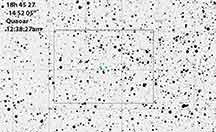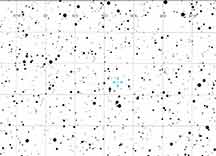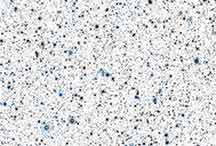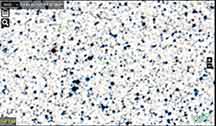




OWc page , LuckyStar page
The path itself misses us, far to the north. But the rings are a possibility. This is a very big ask... the rings of Quaoar have little opacity, so far as we can tell. And the altitude is only 14 degrees above the SE horizon. This will make the star 0.8 magnitudes dimmer than if it were at 66 degrees altitude. The extinction by the atmosphere and the twinkling will make this event I believe nearly impossible. 15.7 mag will then look like W=16.5. 3 magnitudes dimmer than a 13.5. A 13.5 star would, I'd estimate, an integration of 16x to be adequately visible to hope to see a partial occultation by rings. 16x or 1/3 second. But 3 magnitudes dimmer would then require 15.8 times more integration or 5.3s. That's longer than the maximum 256x = 5s integration for the PAL Watec, possible by the Watec. Even so, would 5s be too long to show the occultation by the denser ring?
John Irwin's observation of the ring1 gave a total occultation length of 1.1s, with most of that interval being a shallow partial occultation. So it would seem that a 5s integration would not see any detectable signal. In a 10" we might get away with 2.5s integration, but that's still not going to detect the occultation.
Alt-20.4, Az=128.3 This is above the local horizon for the 12" scope at Cabrillo, by just a few degrees, leaving little time for target acquisition.
The ring geometry will probably be quite similar to the May 2023 event, at a similar place in the local sky and same constellation.
 |
 |
 |
 |
 |
Bernard and I converged on Cabrillo Observatory on a good dark night to give it a try and also accomplish other tasks in support of occultations for Cabrillo and Bernard. I mounted the Watec 910hx PAL on the 12" scope, and was happy to discover that by leaving on the extension tube downstream of the f/6.3, that the Watec came into focus, at a focus setting of 33, vs. the focus setting of 17 for the ST2000xcm camera. Target acquisition was very difficult. The pointing accuracy was not bad; but the star field was so crowded, and I did not have time to make proper finder charts oriented properly and scaled properly. I still found the stars around the target, I believe, but at 64x and 128x the target was not itself visible. The stars were blurry, and the scope pedestal vibrated with any walking about. I will want to get a long RCA jack extension cable to allow me to remain inside the Warm Room for all work, with the OccBox remaining under the telescope but the folding monitor power/video cables to be snaked through the window to sit on the desk next to "Spock". I doubt I got anything usable for the ring occultation(s).
Bernard set up the 10" f/4 Newtonian with his camera and gear just below the dome, outside on the ground next to the steel shed, to get the low altitude target just above Hort Hill. He got successfully onto the target very fast, and recorded. The target star was very very dim and blurry on the screen but might give a detectable light curve with luck. Ring occultation highly unlikely to be detectable, but if we had a grazing incidence of the inner ring where the ring was dense enough, it's not impossible that something surviving S/N might yet show.
We then did a few minutes of calibration video; I using the Watec bare camera aimed at the Observatory outside wall reflecting the flash of Bernard's flash timer. Somehow we'll want to measure the mean offset and dispersion of the flash times vs. the Watec times,